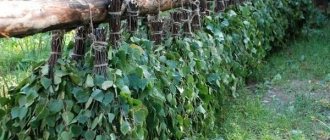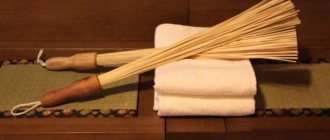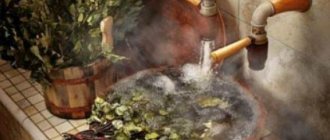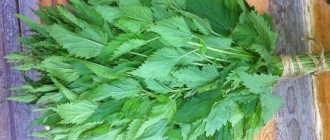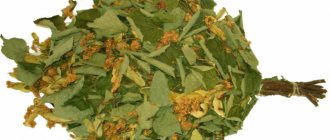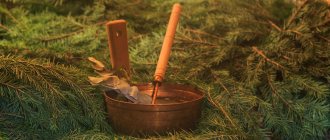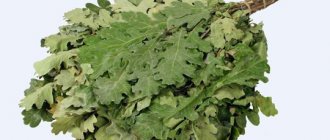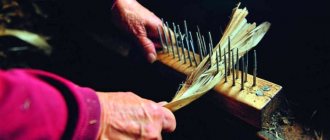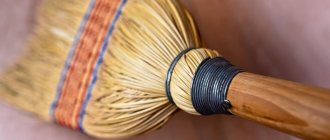Since ancient times, people in Rus' have loved and respected the bathhouse. Since ancient times, the beneficial effect of the Russian bath on humans has been known; in addition, many children's and women's diseases were treated in the steam room. With regular visits to a Russian bath, the immune system is significantly strengthened, stress is relieved, and the skin takes on a healthy, pleasant appearance. And for greater efficiency, fragrant herbs are used, and the heater is watered with aromatic oils.
But what’s a bathhouse without a good broom? Avid steam room lovers, knowing a lot, use a wide variety of bath accessories: birch, fir, oak, ash and even eucalyptus. Each has its own healing focus, for example, oak and pine help well with some skin diseases, and ash treats rheumatism and radiculitis, it is also recommended for arthritis, fir will relieve an old cough. Each of them has its own wonderful properties. Today in this article we will talk about how and where you can prepare a birch broom for a bath, let’s see why they are convenient and useful:
- To prepare brooms for a bathhouse, you don’t need to look for an oak or coniferous forest or go to another country in search of eucalyptus, just take a walk to the nearest grove.
- Goes well with medicinal herbs, nettles, and pine branches.
- It is easier to cut and store than, for example, coniferous.
- Cleanses the skin of toxins, as under high temperature the leaves release flavonoids.
- Increases sweating, much more than oak, which contains tannins.
- It is useful for diseases of asthma and bronchi, and also has a beneficial effect on smokers, since after the steam room the functioning of the bronchi improves, phlegm is released, and ventilation of the lungs improves.
Before you go to harvest any brooms, you should resolve the issue with the local forestry department. The fact is that there are regions where this is strictly prohibited or where legalization is required. In order not to break the law, issue an extract, for example, for one cubic meter of birch twigs, thereby you will protect yourself from unnecessary problems, and besides, it is inexpensive.
Assortment of brooms
Each bath connoisseur chooses a broom for himself, depending on his favorite herbs and the desired medicinal properties. Understanding people say that absolutely every broom has its own unique healing effect. The most common bath brooms include: oak, birch, linden, eucalyptus. The king of all brooms is considered to be birch broom. Brooms made from fir, cedar and nettle, as well as young shoots of cherry, juniper, wormwood, ash, rowan, aspen and bird cherry are used a little less frequently. The so-called combined brooms are very popular. Several branches of aromatic, specific, or medicinal raw materials are added to them. Such additives include: mint, linden, fireweed, St. John's wort, lemon balm, hyssop, juniper, nettle, fir, chamomile, tansy, raspberry, currant. When such a broom is steamed, the bathhouse is filled with the delightful smells of garden and meadow plants. When a combined broom is made, the burning and thorny branches must be placed inside, but there are exceptions when the most burning poultices are needed as a healing process.
Knitting tips
The handle is processed by wrapping the stripped part of the branches with twine. The entire area is rewound without knots and leaves, and at the end the remaining branches or material are carefully trimmed. Thus, you get a neat handle that will not lead to the formation of calluses in the process of whipping a bathhouse visitor. The optimal length is considered to be a handle of 15 centimeters, in which there is no winding under the very leaves, which allows you to make the broom more voluminous. It fits comfortably in the hand and does not slip out of the hand when clapping.
Many experts, when talking about how to prepare brooms for a bath, recommend adding mint stalks, thyme, chamomile or young shoots of black currant between the branches. This will give the product a wonderful aroma and enhance the healing effect of the procedures.
Sometimes, looking at a photo from a bathhouse, you can see that branches of coniferous trees have been added to the broom. It’s worth saying right away that they can only be placed inside, since the needles can damage the skin when whipped.
The weight of the broom is selected according to your own feelings, but, naturally, it should have such a mass that it is easy to hold during procedures.
Procurement period for bath brooms
The best time to start preparing bath brooms is during the flowering period of the grass. At this very time, the leaves are tender, soft and fragrant. You can start preparing on Trinity Sunday - this is a national holiday and is celebrated at different times every year (counted 49 days after Easter). It mainly falls in the first ten days of June. Well, the preparation needs to be completed on August 2 - “Ilya’s Day”. After this holiday, according to popular beliefs, it is impossible to prepare brooms (with the exception of eucalyptus and oak), since they no longer have healing powers. Brooms must be prepared in dry weather.
You need to pay special attention to ensure that the leaf holds well, there are no thorns on the branches, and no resin is released from them. When preparing branches for bath brooms, you need to take into account the main point, do not use raw materials that grow:
• near the roadway;
• near industrial enterprises;
• close to a high-voltage line.
Also treat all plants with care, trim only those branches that you need. You need to choose the youngest plants (2-3 years old), whose branches bend well. Brooms made from birch, which grows near the water, are prized. This kind of birch is popularly called “weeping”. The best branches are those that grow close to the ground. They are thin, flexible, straight, hanging, long.
Some people try the leaf on their tongue: if the leaf is very rough, then it is better not to take it, but if it is velvety and tender, then this is what is needed . You need to cut off the shoots from the sides. Do this using pruning shears. When transporting, it is not recommended to put brooms in any bags or other devices. The most convenient thing is to tie them with a rope and put them in the car in which you came to pick up the brooms. When you arrive home, you need to immediately untie the ropes, otherwise the brooms may cake, and then they will not be elastic and loose. After you have prepared the raw materials, you do not need to immediately start knitting them.
Allow the branches to wither for 2–3 days in a special room where direct sunlight will not fall on them. The next procedure that needs to be done is sorting all the branches by length. Absolutely every branch must be cleared of 1/3 of its leaves. This prevents the broom from disintegrating quickly and is enough for 2-3 sessions. It is best to determine the length of the broom in relation to the height of the steamer and the size of the steam room: that is, you need to take into account the distance from half a mound to the ceiling. The most optimal length is considered to be 400 – 600 mm. The thickness should be such that the accessory is comfortable to hold in the hand of the hairdresser. Start forming the broom from the middle. Take thicker branches and attach thinner ones around them. It is necessary that all branches bend inward. Also, the matte surface of the sheet should be directed inward, and the smooth and shiny surface should look outward.
Broom sorghum: planting and care
When the soil temperature warms up to 15 °C. I sow the seeds in a row method to a depth of 2-4 cm, leaving a distance of 40-50 cm between the rows.
I sow by hand so that there is approximately 2 cm between the seeds. When the seedlings reach a height of 5-7 cm, I thin out the crops, leaving a distance of 5 cm between plants.
I noticed that when the crops are thickened, sorghum lays down.
I do three weedings per season: the first - after the emergence of seedlings, the second - during thinning and the third - when the plants grow to 10-15 cm (at the same time, corrective thinning can be carried out). After this, sorghum begins to grow actively and no longer needs weeding.
At the beginning of the waxy ripeness of the grain, I collect the plants by hand, cutting off their upper part by 80-100 cm, almost to the first node. To clear the grain from the whisk, I insert it between the handle and the edge of a galvanized bucket with the top inside the container and jerk it with a sharp movement. All the grain is poured into a bucket, and the panicle is cleaned.
I sort the resulting raw materials, knit them into bundles and hang them to dry in a well-ventilated place, protected from rain. When the rods are completely dry, I start knitting brooms.
I dry the grain under a canopy.
Most of it is sold, the rest is used to feed poultry and livestock. I remove the stems that remain in the field in late autumn, when I have more free time. I crush them in a crusher and then use them as mulch throughout the next season. As you can see, growing broom sorghum is a very useful and profitable activity.
How to dry bath brooms
The tied brooms need to be dried very well. For this purpose, do not use direct sunlight. The most practical and convenient way to dry is to hang them in the attic of the house, on a thin pole or on thick twine. It is also necessary to pay attention that the brooms do not hang close to each other: this gives them the opportunity to better ventilate and dry.
You can also place the brooms at a short distance from each other in a cool place. After the finished brooms have been distributed for drying, they must be turned over daily. After the brooms have dried, you can put them in a pile and periodically mix (swap) them. Of course, damper brooms should be placed on top. So, well-dried brooms have a delightful appearance and retain their healing and nutritional properties.
How to do something yourself, with your own hands - home craftsman website
AN EXCELLENT TOOL FOR CRAFTERS AND HANDCRAFTS AND EVERYTHING FOR THE GARDEN, HOME AND Cottage LITERALLY FOR FREE + THERE ARE REVIEWS.
Have you ever grown broom sorghum in your garden?
If not, be sure to try it. This is a very necessary crop in the economy. All parts of the sorghum plant can be used: panicles - for making brooms, seeds - for livestock and poultry feed, and stems - for mulching beds .
Sorghum is a high-yielding plant; in the national economy it is used as a grain and fodder crop. The sown area of different types of sorghum in the world is more than 60 million hectares. In Ukraine, it is grown over large areas, mainly in the southern and central regions, since it is a very drought-resistant crop.
But due to global warming, sorghum is now being developed even in the northern regions of our country.
EVERYTHING YOU NEED FOR THIS ARTICLE IS HERE >>>
How to store bath brooms
After the brooms have dried, you need to create conditions for storage for a long time until they are needed. The best option is to store it in the shade, otherwise some of the healing properties will be lost. If you store the broom in the sun, it will become short-lived.
There are several ways to store, everyone chooses the most acceptable and convenient for themselves:
1. On the roof of a house or barn, a hayloft is also a convenient option; make a flooring of hay. The finished brooms are laid out on it so that they do not touch each other tightly. Cover the top with dry hay. When needed, the broom can be easily removed from such storage.
2. Storage in cardboard boxes with holes (so that the brooms can breathe): carefully fold the broom to the broom, swapping the leaf part of the broom and the butt. There is no need to pack them tightly. If you store brooms this way, they will not dry out and will retain their fan shape well.
3. Storage of brooms - on a specially made rack in the dressing room or any other room. The most important conditions for the room: good ventilation and dryness.
The most popular method of storage in villages at present is in a utility room, or in a dressing room in a hanging position on twine or a thin pole, tied in pairs. Also, between the ready-made brooms, you can place a bouquet of medicinal herbs, which will play a double role: they can be brewed and drunk as tea, or brewed in a bathhouse for aroma. This method is good and useful, but when stored this way, the brooms very often dry out and, accordingly, the leaves begin to crumble. With this storage method it is very difficult to achieve the correct shape of the broom (the broom should be like a fan).
An interesting storage option in a haystack. Steam lovers have adapted to storing bath brooms in urban environments: in the refrigerator in a plastic bag or on the balcony. If all processes are followed well from start to finish, the shelf life of bath brooms is approximately 2 years. At the same time, all beneficial properties are completely preserved. Well, basically, all the secrets of preparing a bath accessory have been revealed. Research by professionals shows that observing all the age-old traditions and technologies of collecting and using medicinal plants, including the process of preparing bath brooms of various types, preserves the maximum amount of nutrients and medicinal substances.
Contraindications
In principle, visiting the steam room is not allowed for everyone. In some conditions, a bath will do more harm, even if you steam a fragrant fir broom and follow all the rules of active massage. In particular, procedures should be abandoned if:
- diabetes mellitus;
- heart failure;
- hypertension;
- tuberculosis;
- inflammatory diseases of the genitourinary system;
- pregnancy.
You can steam a fir bath broom only if there are no wounds or abrasions on the skin. Massage procedures in the steam room cannot be performed in case of infectious diseases of the epidermis.
Conditional contraindications for the bath also include alcoholic drinks and rich fatty foods. You need to steam a broom and go into a heated room while sober and a certain time after eating.
Is there an allergy from a fir broom?
Steaming fir for a bath is not always useful. For some people, the pine aroma causes severe allergies, and a negative reaction can occur directly during the steaming process. Redness of the skin when treated with a broom in a bath is a completely natural and inevitable phenomenon. But if the redness is accompanied by a characteristic rash, the eyes begin to water, a runny nose and swelling of the mucous membranes occurs, we can conclude that we are talking about an allergy. In this case, the procedure should be stopped and the fir branches should not be steamed in the future.
